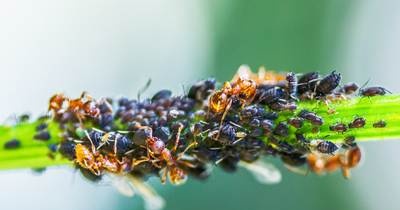|
 Caring for indoor and garden plants can often be complicated by the presence of all sorts of insects, fungi, bacteria and viruses. The causative agents of diseases can penetrate the tissues, as well as the seeds of the plant. In addition, unsuitable environmental conditions negatively affect the vitality of flowers. A warm environment combined with high humidity encourages the spread of insects, ticks and other parasites. Sometimes it is quite problematic to determine the exact disease. Let's consider the most common pests. Caring for indoor and garden plants can often be complicated by the presence of all sorts of insects, fungi, bacteria and viruses. The causative agents of diseases can penetrate the tissues, as well as the seeds of the plant. In addition, unsuitable environmental conditions negatively affect the vitality of flowers. A warm environment combined with high humidity encourages the spread of insects, ticks and other parasites. Sometimes it is quite problematic to determine the exact disease. Let's consider the most common pests.
Worms
The scale insects belong to the suborder Coccidaceae, about 2-5 mm in size. The larvae of the worms stick to the plant, forming protective covers. Some species can approximately 4 generations annually. Among the bugs, mealy, varnish, and felt are distinguished. Insects have a pronounced wax cover. Reproduction occurs most actively in a humid, warm environment. Worms settle on the leaves of plants or on shoots. Leaves damaged by worms become deformed and wither.
As a means of combating worms, various insecticides are used, sprayed on the affected areas (10 g per bucket of water). In the event that insects have settled on indoor plants, it is better to use a brush or cotton swab, wiping off the surface of the leaves of the bugs.
Snails
Gastropods that feed on herbaceous plants. They destroy the surface of the leaves, forming holes. Irreparable harm is done to young plants. The main sign of the appearance of snails is the presence of silvery mucus on the surface of the leaves. The most vulnerable plants are fern, fittonia, anthurium, poinsettia.
If pests live in a limited area, then it is better to collect them by hand. Snails don't like light, so they hide in damp, dark places during the day. If the affected area is larger, then a bait based on copper sulfate is laid next to the plant.
 Aphids Aphids
The body length of the insect reaches 2-3 mm, they live in colonies. The color varies from light green to brown. Aphids damage young shoots, deforming them. Insects suck the sap from the plants, as a result of which the leaves curl and gradually dry out. The greatest threat is posed to such plants as rose, orchid, apple, cherry, plum, peach tree.
Aphids are common both at home and in the garden. Peretrin-based preparations will help to cope with them. Pemoris is also an effective remedy. If they treat the upper part of the leaves of the plant, then it will penetrate down, where aphids are often located, and completely eliminate them. Approximately 2-5 g of the drug is dissolved in a bucket of water and sprayed onto the lesions. In total, 2-3 treatments are applicable per season.
Strawberry and spider mites
Ticks are small in size and outwardly similar to spiders. Eat plant sap. You can see these insects on the back of the leaves. The appearance of mites is accompanied by discolored specks that gradually turn into white or yellow spots. Over time, the leaves turn yellow completely, and subsequently dry out. Adults of the earth mite are visible only through a magnifying glass, the body is flat, yellow. The strawberry mite lives on young shoots. The rise in temperature and humidity promotes the growth and reproduction of insects. When damaged, the leaves curl, in places they acquire a bronze color. The spider mite is very small, has 4 pairs of legs, the body is greenish-yellow with black spots. They are formed on the underside of the sheet and entangle them with cobwebs. Many ornamental plants are attacked by ticks. Among them are tulip, carnation, camellia, gladiolus, gerbera, rose.
The fight against the pest is complicated by the fact that, in addition to adults, eggs are located on the leaves. Many drugs are designed to eliminate either ticks only or eggs alone. Therefore, it is better to carry out about 2 treatments with a time interval. The drug used must be replaced periodically, since mites tend to get used to spraying, which makes it difficult to get rid of them. Difokol and tetradiphone are widely used. Dimethoate is used with extreme caution, as it is toxic and causes burns on plants.
Before you start breeding garden and indoor plants, you need to study the rules for caring for them and create favorable conditions. In the event of plant contamination, the most suitable preparations should be selected and familiarized with the methods of their use.
Hegelbach A.
Forum about garden and vegetable garden
|